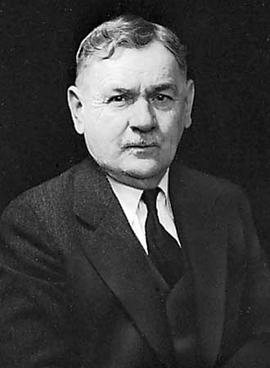Related Research Articles

Clark David Wissler was an American anthropologist, ethnologist, and archaeologist.

Behavioral modernity is a suite of behavioral and cognitive traits that distinguishes current Homo sapiens from other anatomically modern humans, hominins, and primates. Most scholars agree that modern human behavior can be characterized by abstract thinking, planning depth, symbolic behavior, music and dance, exploitation of large game, and blade technology, among others. Underlying these behaviors and technological innovations are cognitive and cultural foundations that have been documented experimentally and ethnographically by evolutionary and cultural anthropologists. These human universal patterns include cumulative cultural adaptation, social norms, language, and extensive help and cooperation beyond close kin.
Osteology is the scientific study of bones, practised by osteologists. A subdiscipline of anatomy, anthropology, and paleontology, osteology is the detailed study of the structure of bones, skeletal elements, teeth, microbone morphology, function, disease, pathology, the process of ossification, and the resistance and hardness of bones (biophysics).
In cultural anthropology and cultural geography, cultural diffusion, as conceptualized by Leo Frobenius in his 1897/98 publication Der westafrikanische Kulturkreis, is the spread of cultural items—such as ideas, styles, religions, technologies, languages—between individuals, whether within a single culture or from one culture to another. It is distinct from the diffusion of innovations within a specific culture. Examples of diffusion include the spread of the war chariot and iron smelting in ancient times, and the use of automobiles and Western business suits in the 20th century.

Charles Gabriel Seligman FRS FRAI was a British physician and ethnologist. His main ethnographic work described the culture of the Vedda people of Sri Lanka and the Shilluk people of the Sudan. He was a professor at London School of Economics and was highly influential as the teacher of such notable anthropologists as Bronisław Malinowski, E. E. Evans-Pritchard and Meyer Fortes all of whose work overshadowed his own.
The evolution of human intelligence is closely tied to the evolution of the human brain and to the origin of language. The timeline of human evolution spans approximately seven million years, from the separation of the genus Pan until the emergence of behavioral modernity by 50,000 years ago. The first three million years of this timeline concern Sahelanthropus, the following two million concern Australopithecus and the final two million span the history of the genus Homo in the Paleolithic era.
The Maritime Archaic is a North American cultural complex of the Late Archaic along the coast of Newfoundland, the Canadian Maritimes and northern New England. The Maritime Archaic began in approximately 7000 BC and lasted into the 18th century. The culture consisted of sea-mammal hunters in the subarctic who used wooden boats. Maritime Archaic sites have been found as far south as Maine and as far north as Labrador. Their settlements included longhouses, and boat-topped temporary or seasonal houses. They engaged in long-distance trade, as shown by white chert from northern Labrador being found as far south as Maine.
Human behavioral ecology (HBE) or human evolutionary ecology applies the principles of evolutionary theory and optimization to the study of human behavioral and cultural diversity. HBE examines the adaptive design of traits, behaviors, and life histories of humans in an ecological context. One aim of modern human behavioral ecology is to determine how ecological and social factors influence and shape behavioral flexibility within and between human populations. Among other things, HBE attempts to explain variation in human behavior as adaptive solutions to the competing life-history demands of growth, development, reproduction, parental care, and mate acquisition.
Dual inheritance theory (DIT), also known as gene–culture coevolution or biocultural evolution, was developed in the 1960s through early 1980s to explain how human behavior is a product of two different and interacting evolutionary processes: genetic evolution and cultural evolution. Genes and culture continually interact in a feedback loop, changes in genes can lead to changes in culture which can then influence genetic selection, and vice versa. One of the theory's central claims is that culture evolves partly through a Darwinian selection process, which dual inheritance theorists often describe by analogy to genetic evolution.
Cultural selection theory is the study of cultural change modelled on theories of evolutionary biology. Cultural selection theory has so far never been a separate discipline. However it has been proposed that human culture exhibits key Darwinian evolutionary properties, and "the structure of a science of cultural evolution should share fundamental features with the structure of the science of biological evolution". In addition to Darwin's work the term historically covers a diverse range of theories from both the sciences and the humanities including those of Lamark, politics and economics e.g. Bagehot, anthropology e.g. Edward B. Tylor, literature e.g. Ferdinand Brunetière, evolutionary ethics e.g. Leslie Stephen, sociology e.g. Albert Keller, anthropology e.g. Bronislaw Malinowski, Biosciences e.g. Alex Mesoudi, geography e.g. Richard Ormrod, sociobiology and biodiversity e.g. E.O. Wilson, computer programming e.g. Richard Brodie, and other fields e.g. Neoevolutionism, and Evolutionary archaeology.
The Standard Cross-Cultural Sample (SCCS) is a sample of 186 cultures used by scholars engaged in cross-cultural studies.
Stanley Marion Garn Ph.D. was a human biologist and educator. He was Professor of Anthropology at the College for Literature, Science and Arts and Professor of Nutrition at the School of Public Health at the University of Michigan. He joined the University of Michigan in 1968.
A cultural universal is an element, pattern, trait, or institution that is common to all known human cultures worldwide. Taken together, the whole body of cultural universals is known as the human condition. Evolutionary psychologists hold that behaviors or traits that occur universally in all cultures are good candidates for evolutionary adaptations. Some anthropological and sociological theorists that take a cultural relativist perspective may deny the existence of cultural universals: the extent to which these universals are "cultural" in the narrow sense, or in fact biologically inherited behavior is an issue of "nature versus nurture". Prominent scholars on the topic include Emile Durkheim, George Murdock, Claude Lévi-Strauss, and Donald Brown.
A. Roberto Frisancho is a biological anthropologist and the Arthur F. Thurnau Professor of Anthropology at the University of Michigan. He is the 2008 recipient of the Franz Boas Distinguished Achievement Award in Anthropology bestowed by the American Human Biology Association. He is best known for his work on developmental human adaptation to extreme environments such as high altitudes, growth, anthropometry and evaluation of nutritional status. Specifically, he advanced the hypothesis and demonstrated that the origin of adult variability of biological phenotypic traits are function of the effects and adaptations to environmental conditions that the organism makes during the developmental stage. Within this conceptual framework, he has contributed numerous papers on bioenergetics, the nutrition and developmental determinants of pre-natal and post-natal growth including teenage pregnancy. In 2013, he received the Charles Darwin Lifetime Achievement Award bestowed by the American Association of Physical Anthropologists.
Self-domestication is the process of adaptation of for example wild animals to cohabiting with humans, without direct human selective breeding of the animals. The human self-domestication hypothesis argues that, like mammalian domesticates, humans have gone through a process of selection against aggression – a process that in the case of humans was self-induced, in favor of social behavior from which the group as a whole benefited, such as intelligence, soft skills, emotional intelligence and where individuals with an antisocial personality disorder would be eliminated by the group. For this to happen, sophisticated language was necessary to plot against the bully or individual with excessive aggressive behavior, so one would not be killed themselves. It is hypothesized that this is what differentiated Homo erectus and Homo neanderthalensis from H. sapiens: the ability of sophisticated language, allowing better social collaboration, elimination of excessive aggressive behavior in the group, leading to self-domestication and could explain why only homo sapiens survived from all the hominae. Dogs and cats have undergone this kind of self-domestication. Self-domestication also refers to the evolution of hominids, particularly humans and bonobos, toward collaborative, docile behavior. As described by British biological anthropologist Richard Wrangham, self-domestication involves being in an environment that favors reduction in aggression, including interspecific and intraspecific antagonism, for survival. Spandrels, or evolutionary byproducts, also accompany self-domestication, including depigmentation, arrested development, and reduced sexual dimorphism.

The Slab-Grave culture is an archaeological culture of the Late Bronze Age and Early Iron Age Mongols. The ethnogenesis of modern Mongolian people is linked to the Slab-Grave culture by historical and archaeological evidence, and genetic research also links modern Mongolians to the Slab Grave culture.
Anzick-1 is a Paleo-Indian male infant whose remains were found in south central Montana, United States, in 1968, and date to 13,000–12,850 years BP. The child was found with more than 115 tools made of stone and antlers and dusted with red ocher, suggesting an honorary burial. Anzick-1 is the only human who has been discovered from the Clovis Complex, and is the first ancient Native American genome to be fully sequenced.
Mortuary archaeology is the study of human remains in their archaeological context. This is a known sub-field of bioarchaeology, which is a field that focuses on gathering important information based on the skeleton of an individual. Bioarchaeology stems from the practice of human osteology which is the anatomical study of skeletal remains. Mortuary archaeology, as well as the overarching field it resides in, aims to generate an understanding of disease, migration, health, nutrition, gender, status, and kinship among past populations. Ultimately, these topics help to produce a picture of the daily lives of past individuals. Mortuary archaeologists draw upon the humanities, as well as social and hard sciences to have a full understanding of the individual.

The Knoll Spring site (11Ck-19), aka Au Sagaunashke village, is located in the Sag Valley, Palos Hills, in Cook County, Illinois, near the city of Chicago. It is classified as a late prehistoric site with Upper Mississippian Huber affiliation.
The Anker Site (11Ck-21) is located on the Little Calumet River near Chicago, Illinois. It is classified as a late prehistoric site with Upper Mississippian Huber affiliation.
References
- ↑ Historical Inferences from Guttman Scales: The Return of Age-Area Magic? Theodore D. Graves; Nancy B. Graves; Michael J. Kobrin Current Anthropology, Vol. 10, No. 4. (Oct., 1969), pp. 317-338.